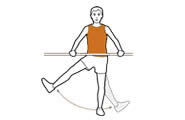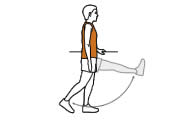Static stretching involves reaching forward to a point of tension and holding the stretch for 30 seconds. A static stretch includes the relaxation and concurrent elongation of the stretched muscle. Stretching in this manner alters the length-tension relationship in muscles and therefore will reduce the muscles ability to produce power – in other words it may detrimentally affect performance. There has been some research, however, claiming that shorter duration of pre-exercise static stretching does not compromise maximal muscle performance. And others claiming that statically stretching the hip-flexor muscles increases the performance of a hip extension exercise, such as the vertical jump. In other words….it’s not a simply question.

 Generally you should be aiming to perform dynamic stretching (such as controlled leg and arm swings that take you gently to the limits of your range of motion) and mobility drills (which place an emphasis on the movement requirements of Hapkido rather than on individual muscles) before class, as these have been shown to enhance performance. Any static stretching should be done either after class (when your body is warm) or at another point in your week. Examples of some mobility drills can be found in the member’s area of the Chang’s Hapkido Academy UK website.
Generally you should be aiming to perform dynamic stretching (such as controlled leg and arm swings that take you gently to the limits of your range of motion) and mobility drills (which place an emphasis on the movement requirements of Hapkido rather than on individual muscles) before class, as these have been shown to enhance performance. Any static stretching should be done either after class (when your body is warm) or at another point in your week. Examples of some mobility drills can be found in the member’s area of the Chang’s Hapkido Academy UK website.
Key Points
- Limiting the use of static stretching before activity may well reduce the chance of decreasing performance levels. Though, low volume and moderate intensity static stretching may be beneficial where extreme ranges of movement are required.
- Longer duration stretching protocols should be avoided prior to performance.
- An active warm-up with dynamic stretching and mobility exercises is key to performance.
